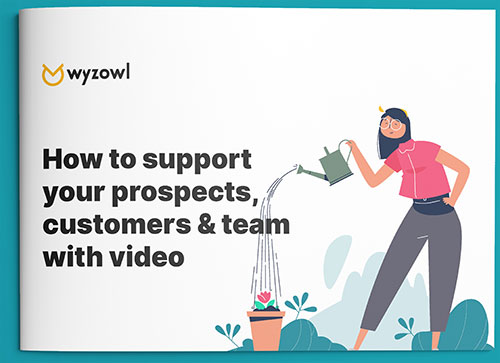Last updated on 1st December 2023
Onboarding – the education that takes place as a new user has an initial experience with your product or service – is often the first impression you make on a customer. When done well, great onboarding creates a positive experience with a new product, builds value, improves client retention statistics, and increases profitability.
Back in 2020, we surveyed 216 people to collect data on customer onboarding. We asked questions about how onboarding has impacted their experiences, how brands do when it comes to onboarding, and how onboarding experiences could be improved. In this post, we’ll break down five of our onboarding statistics that prove the power of this tool, and share some tips on how to make video onboarding work for your brand. They’re as relevant today as ever!
91% of people have watched a video to understand how to use a physical product better
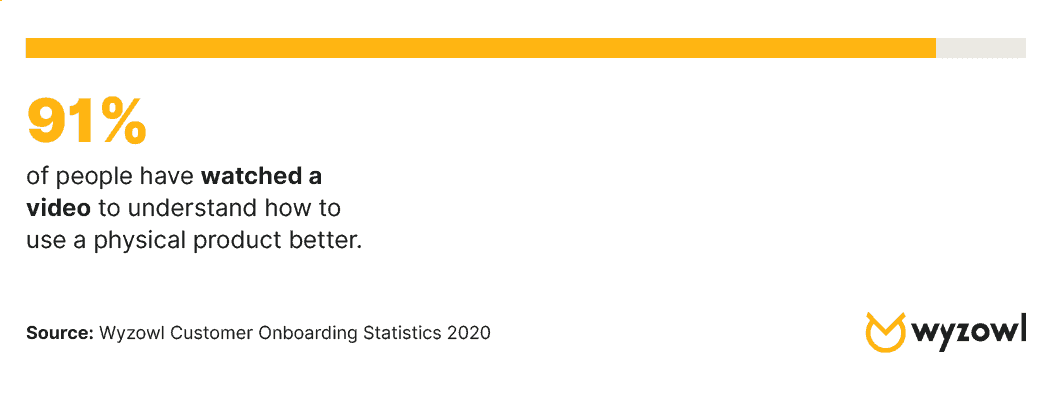
Picture this: you finally get a new product you’ve been waiting for – a vacuum cleaner, a lawn mower, a piece of furniture, or another product that requires some assembly or technical knowledge before you use it. After ripping the box open, do you immediately search for the long, verbose, and oftentimes confusing instruction manual to get started? Probably not. You might even toss that in the trash out of habit. Instead, you probably turn to the internet and find a video that helps you use your new product for the first time. Like this example from Dyson on how to use their Smart Ball upright vacuum:
It’s easy to see why 91% of people have watched a video to better understand a physical product. Sorting through pieces and trying to put parts together isn’t most people’s idea of fun; consumers want the most quick and pain-free educational experience so they can get to using their product, not setting it up.
If the idea of a new vacuum doesn’t have you racing home to rip open the box and start using it, maybe a new video gaming system will. Check out another great example of an onboarding video that shows users how to set up their PlayStation VR.
While it’s great for consumers, this kind of onboarding video creates a lot of opportunities for companies too. For example, if a customer understands how to use a product, they’re less likely to return it or leave a bad review than someone who has trouble setting up their new product, thus improving retention statistics.
But these videos can also require a lot of maintenance for companies that place heavy emphasis on product development. If your company releases new product models regularly, you may need to perform regular video inventory management to ensure your videos are up-to-date; if a customer finds a video for a product that doesn’t reflect the latest model, their first experience with the product will be frustrating. But if you update your video library as you launch new products and models, these onboarding videos can enhance the customer experience and empower your customers to enjoy their product just moments after they acquire it.
74% of people have watched a video to understand how to use a new app or website better
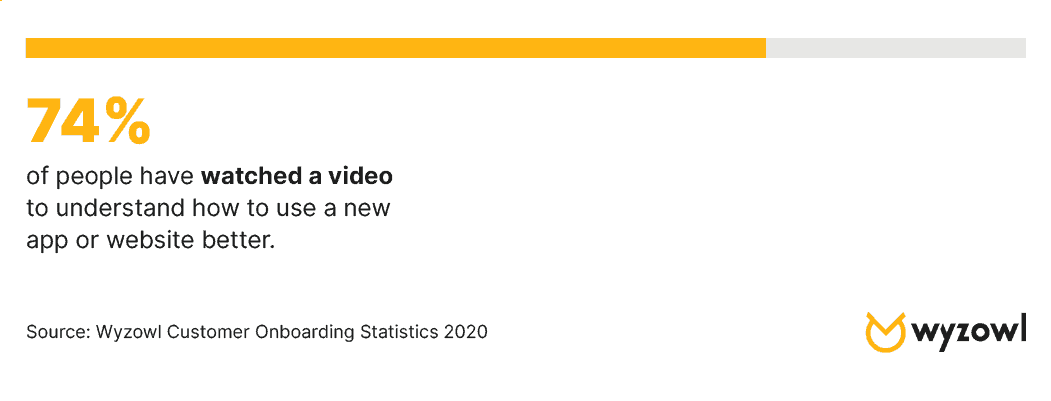
Just like physical products, digital products – like software, mobile apps, websites, and web platforms – are enhanced with video onboarding. Navigating a new digital tool takes a lot of getting used to. Think about the last time you used a new CRM, accounting software, e-commerce platform, or even just a complex website. Those interfaces can take time to learn, which is frustrating when you are using the tool to do something important.
When first logging on, most users don’t know how to access the features they need, and may not even know what features are available to them. Video onboarding solves that problem. These videos are especially great for digital environments because they can show the product in context, walking users through actual screen-recorded videos – like this example from QuickBooks Online that shows new users how to access the program’s basic features:
These kinds of videos can also relieve customer service teams who field incoming calls and emails about product issues; if a video explains common issues customers experience during set-up, those customers are more likely to be successful in their at-home usage and thus less likely to contact customer support.
97% of people think that video is an effective tool to welcome and educate new customers
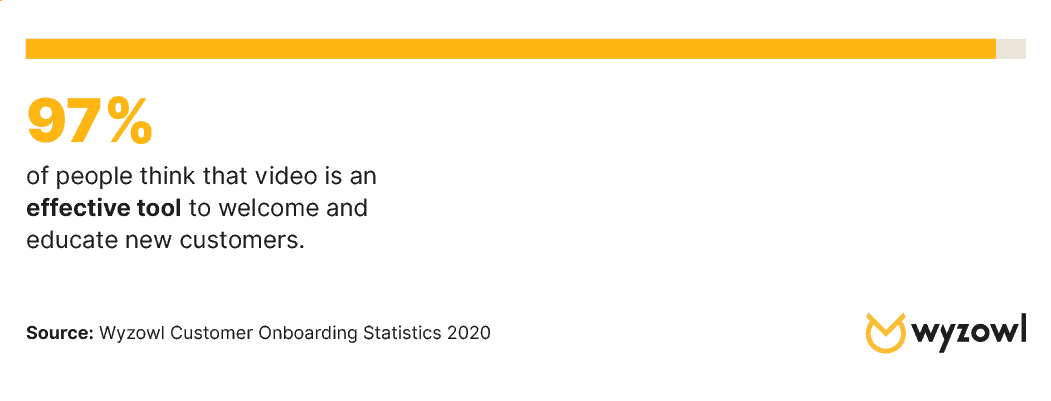
Out of all the onboarding statistics in this list, this one is the most striking: nearly everyone we surveyed believes onboarding videos work. In addition to welcoming and educating new customers, we know video onboarding also adds value to the customer experience, reduces customer dissatisfaction, and can increase retention statistics.
For a great example, check out this onboarding video from Asana that shows brand new customers how to use the product’s basic features like projects and tasks:
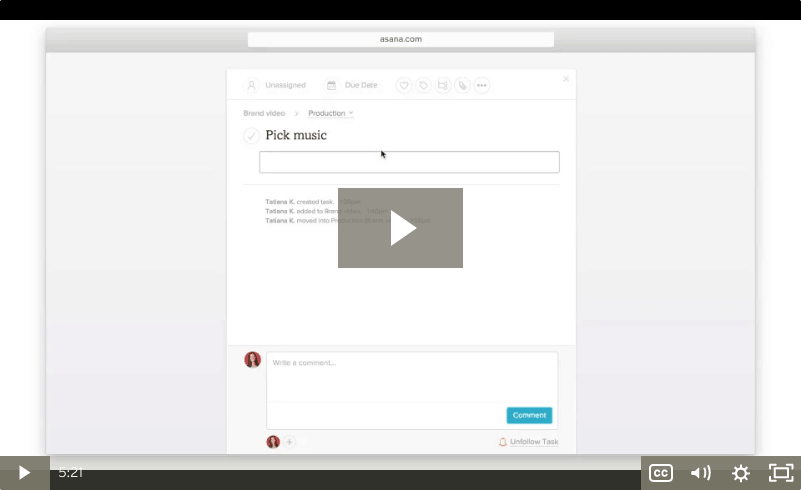
In less than six minutes, the video breaks down Asana’s fundamental functionalities – a process that could take a new user hours of frustration, and could even result in increased churn, or the process of losing customers.
For another great example, check out how McDonald’s introduced customers to their new app with an onboarding video. This animated video provides step-by-step instructions on how to order food, and shows off other features available within the app such as menu information, feedback functionality and so on.
As you’re thinking about how to make your onboarding video extra welcoming and educational, put yourself in the shoes of your customer. Go through the process of using your product for the first time – whether that means pretending like you just received a package from an e-commerce purchase or downloaded a new app. Consider what questions you would have along the customer journey, and where you might get stuck.
You can also conduct onboarding research by having real-world consumers engage with your product for the first time; watch for moments where they hesitate and don’t know what to do next, or where they skip over an important step. Then craft your onboarding video around those gaps as you create a warm and educational experience for your new customers.
When asked how they feel companies could improve re. onboarding, 69% of people say that they feel more video should be used
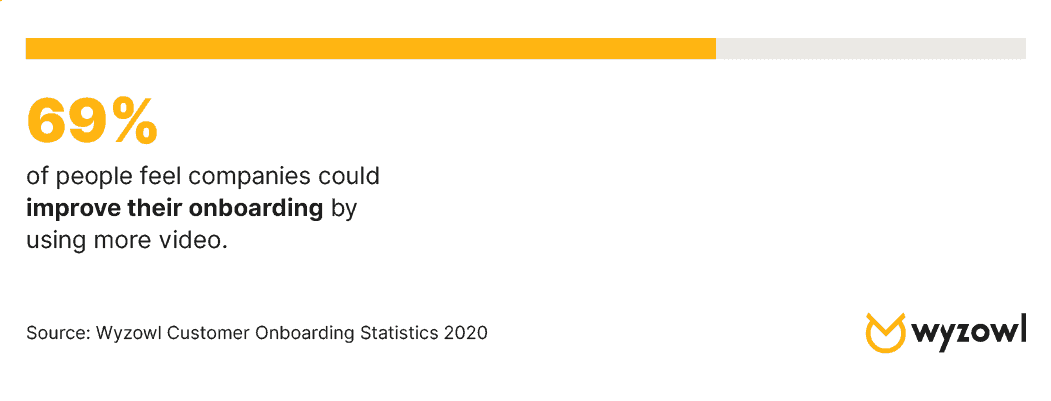
Not only do consumers love onboarding videos, but they’re literally asking that companies consider using them more. The majority of people feel that video is a great tool for helping them learn how to use a product and take advantage of its features.
For a great example, take a look at this onboarding video from Apple. Sure, the company could have included a tutorial document in the iPhone packaging to tell users how to activate their Voice Control features on their iPhones – but why tell when you could show? Users can watch this video and navigate through their iPhone at the same time, learning how to use this feature in just over three minutes.
This strategy doesn’t just enhance digital products; it can make the physical product experience better too. For another great example, check out this Starbucks how-to video that shows customers how to make pour-over coffee. This strategy is notable because the video isn’t a promotion of the pour-over tools themselves, but of Starbucks coffee. In showing customers another way to enjoy their favourite bean brand, they’re also creating new opportunities to earn their business and onboard them to the at-home Starbucks experience.
If you haven’t explored how to use this tool to improve your customer experience, it’s time to get on the video onboarding bandwagon! But this doesn’t mean you should rush to create your first onboarding video too quickly. If this is your company’s first time experimenting with video onboarding, be sure to take time to strategise your approach. For example, your video could leverage screen recordings (which is a great solution for digital products and apps), live-action video (which is great for physical products), and animations or graphic overlays (which can enhance any kind of onboarding video).
You also want to carefully think through all of the other elements of your video, like your script and voice over, whether you’ll use music, whether you’ll feature real customers in your video, your location, and more. Finally, you’ll want to consider how you produce your video. If you have high-quality recording equipment available to you, you could create these videos in-house, but many organisations choose to partner with a video production company, especially as they’re getting started.
Shameless plug: If you’re interested in creating an onboarding video to get your customers up and running quicker than ever before, do get in touch. You can see more about this on our onboarding videos page.
65% of customers say video is their favourite way to get to know how to use a product or service
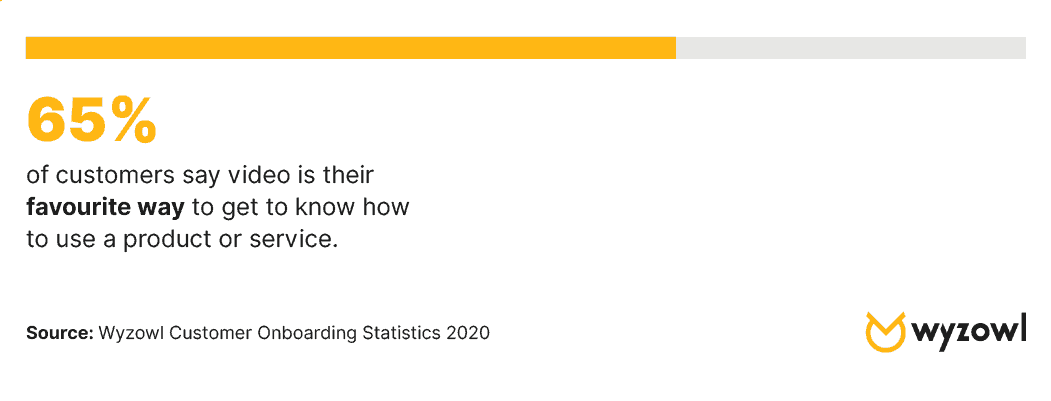
Consumers. Love. Videos. People watch an average of 19 hours of online video per week and are twice as likely to share video content with their friends than any other type of content. So it makes sense that the majority of people prefer to get to know a product or service via video, especially when those videos are short, sweet, and entertaining. Check out this example from IKEA that shows users how to use the augmented reality Create Your Space feature on their Catalog App:
Understandably, explaining augmented reality to a consumer requires visuals; the concept is relatively new in the marketing space, and customers likely won’t “get it” without seeing the tool in action, making video the perfect channel for this onboarding process.
The benefits of an onboarding video like this are vast; these pieces of content are easily shareable and do double duty, serving as both an onboarding tool and as a marketing and customer acquisition piece. For example, the IKEA video above could just as easily help educate existing customers who downloaded their app and recruit new ones via social media and email marketing promotions.
While these onboarding videos do a lot of the heavy lifting, sometimes you need to couple them with additional resources like modals, coach marks, or tool tips. You can learn more about the most common types of onboarding methods in The ultimate guide to onboarding users with video.
Wrapping up
Onboarding can happen through a variety of tools, like instruction manuals, live demos, product walkthroughs, images, instructions on printed packaging, and videos. Many brands are leveraging the power of video to onboard new customers, sharing tutorial-style videos via email, on their website, in FAQ sections, and on social platforms.
As you can see, onboarding videos are a valuable weapon to have in your marketing arsenal. Here are a few reasons why they work so well for physical products, digital products, and service companies alike:
They’re visual: The glory days of the long, dry, boring instruction manual are over. (Seriously, why do they even make those things anymore?) Consumers prefer interacting with more dynamic content that shows the product in use or features screen recordings for more helpful, interesting, and contextual instructions.
They’re a marketing and sales tool: With onboarding videos, you have more control over the initial customer experience. In addition to onboarding users to basic features, you can introduce new ones they might not have found through their own exploration, increasing the value you deliver and your retention statistics.
They take weight off your support team: When users have access to videos that show them how to use your product, they don’t need to call your customer support team and wait for a representative – a process that isn’t fun for your rep or your customer.
They’re proven: These five findings alone prove the power of video as a successful customer experience tool. Couple that with what we know about video and consumer behavior (and how much people love watching videos) and it’s easy to see why these onboarding tools deliver serious ROI for marketers.
For more onboarding statistics, check out our comprehensive research report. And to continue your exploration of how to use onboarding as a way to add value to the user experience and your own business processes, check out How Onboarding Optimises User Retention for more.






